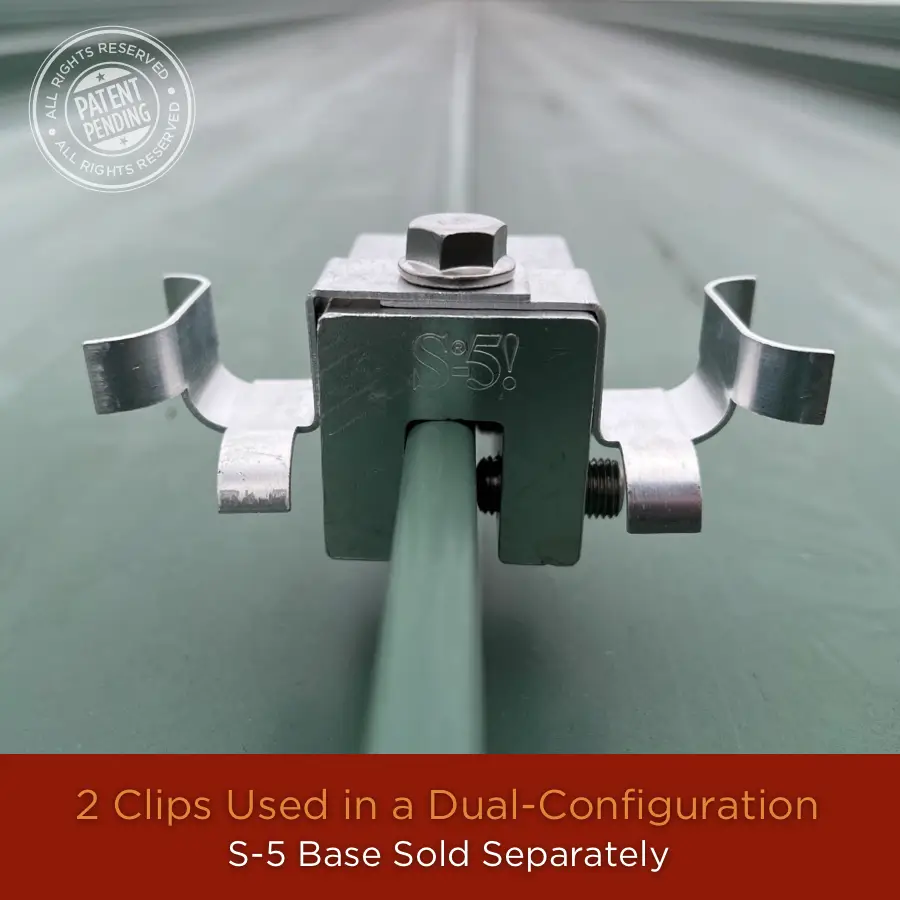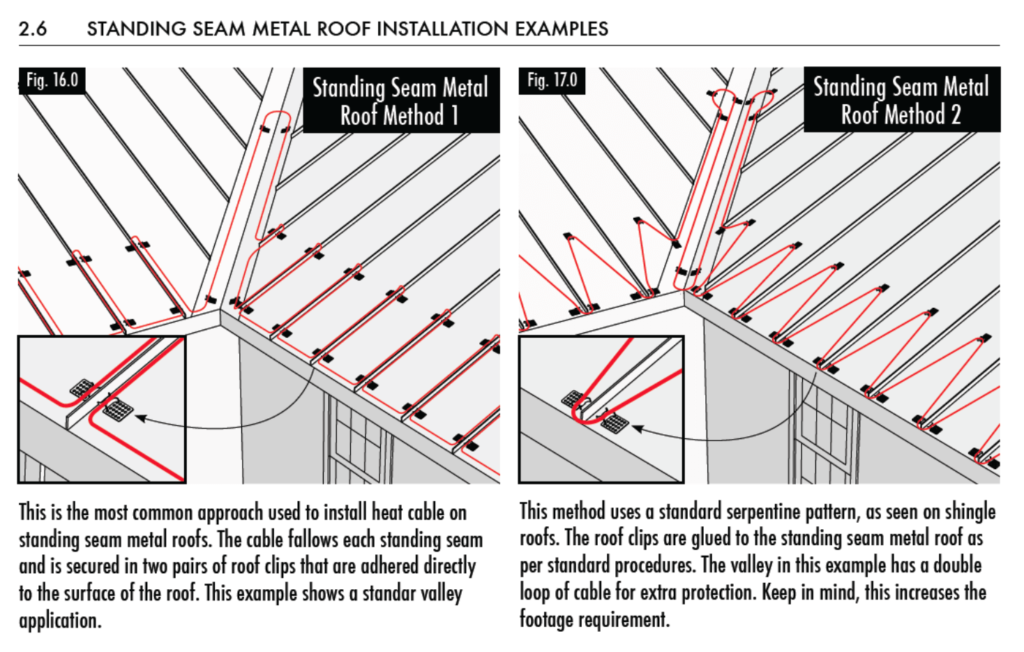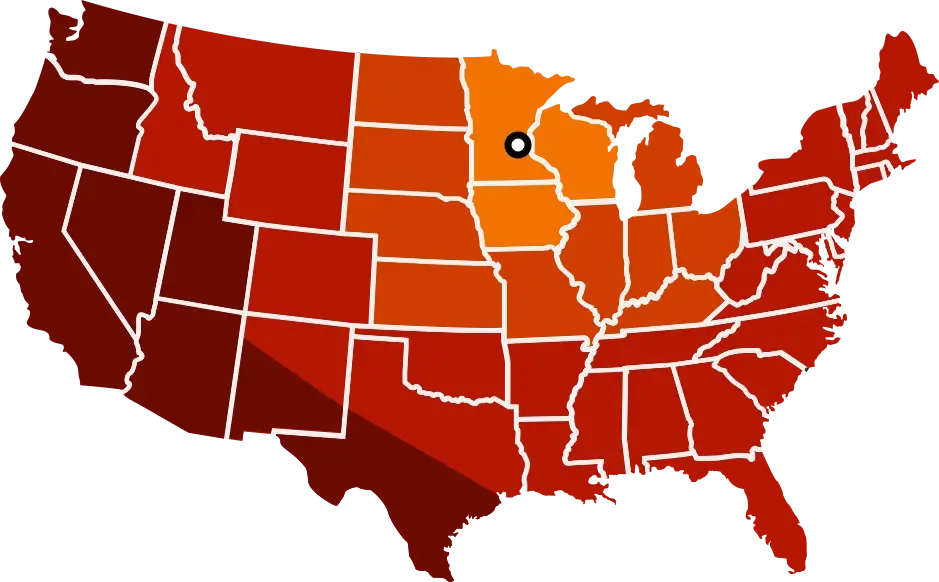FAQs
Frequently Asked Questions
Use the topic search and category filtration to narrow focus for a specific question. Click “Clear All Filters” to remove search and filters. Numbers in parenthesis next to categories represent FAQ count relative to your search and filtration.
My Heat Tape is self-regulating. Do I need a switch or controller?
Self-Regulating Heat Tape will draw variable Power depending on the ambient temperature. It draws more power when temperatures are cold and less power when temperatures are warmer. However when the self-regulating cable is plugged in, it is always working, even if only slightly drawing power in warm temperatures. Adding the temperature-controlled switch like ThermaCord to plug-in heat tape or a Thermostatic Controller with Sensor to field assembled cable, will cut the supply of power to your Heat tape when it is not needed.
This will save you energy Costs.
How do I know how much heat tape to get?
Check Out Our Heat Tape Calculator!
You can use our Heat Tape Calculator to help you determine the length of heat tape you need, the number of GripClips, nail-on heat tape clips, and the number of Downspout Hangers you need.
Will my heat tape turn itself off?
The short answer is NO. Self-regulating heat cable does not turn itself on and off automatically. To do that you need to put the cable on a switched circuit or outlet or on a controller. Of course, you can also be old-school about it and simply plug and unplug as needed.
“Self-Regulating” refers to the fact that these cables are temperature sensitive. Due to their construction, these cables sense changes in temperature along their entire length, demanding more power as temps fall and less when they rise.
PipeFreeeze Pro™, Pipe Freeze Protection Solution has a built in thermostatic switch, meaning it will turn on and off on it’s own.
Heat Tape Pro™, does not contain a built-in thermostatic controller. We recommend adding the ThermaCord™ Thermostatic controller to turn your Heat Tape PRO to turn the cable on and off with changes in temperature.
How do I know if the heat tape is working?
Good news. Heat Tape Pro and Pipe Freeze Pro are the only heat cables in the world you can see is working. The GlowCap is the LED end cap used to terminate all of our pre-terminated heat cables. If you see the green light glowing at the end of the cable, the cable is working. We also offer a GlowCap End Seal Kit for field assembled cable systems.
Another quite obvious way of determining if your heat cable is working is to feel if it is warm.
How hot does Your Heat Tape Get?
Not as hot as your forehead.
Radiant Solutions Self-Regulating Heat Tape changes its heat output based on the temperatures of its surrounding environment. At any given point, depending on the temperatures outside, the cable could be a range of temperatures. However, its peak temperature is not very hot –typically between 60º-85º when operating in a cool environment. Another way to think about it is that as long as the cable is above freezing it will do its job, which is to create and maintain melted pathways through snow and ice.
This gives our Heat Tape a great advantage over the heat tape you can buy in ‘Big Box’ retailers, because it creates enough warmth to effectively do its job, but won’t do damage to surfaces that it touches. Additionally, our heat cable can be overlapped without concern. Heat Tape that is not self-regulating (i.e., ‘constant wattage’) can not do this (they have explicit warnings in the directions not to do this for risk of fire).
We have even witnessed a coil of crappy big box heat tape starting a fire because it got plugged in when it was still coiled. (Yikes!)
What is Self-Regulating Heat Tape?
Heat Tape purchased in big-box stores is most often constant wattage heat tape. “Constant Wattage” means: it’s always on. It is always drawing full power and is costing you peak energy expenses, which –over the length of a season can add up huge. Thought you were saving money on that heat tape you got at that home improvement store? Guess again.
Radiant Solutions’ Heat Tape PRO™ heating cable is Self-Regulating. This means, as the temperature gets colder, the cable creates more heat by drawing more power and when it gets warmer it creates less heat by drawing less power. This allows you to consume only the energy you need to help protect your home from damage caused by the ice and cold.
How can it do this?
The core of our ice dam heat tape is comprised of two bus wires encased in a material that is infused with carbon. As ambient temperatures decrease, the core material shrinks pulling the bus wires closer to each other, creating more electrical pathways through the carbon which makes the cables heat up. When ambient temperatures get warmer, the inner core expands and the cable demands less energy and creates less heat.
Can’t I just accomplish this with constant wattage heat tape and a “switch” or thermostatic control?
No, not really. Because any control or switch is still going to tell your constant wattage cable to be either off or on at 100% power. It is very binary. Conversely, Self-regulating Heat Tape will output variable temperatures based on the external, ambient temperature. So when it’s 31ºF or 10ºF constant wattage heat tape will always be on full heat, where self-regulating heat tape will only use just enough power to be at the temperature you need to prevent ice dams on the roof or frozen pipes around your property.
There’s also some safety considerations.
Among other things, constant wattage heat cable cannot be overlapped without creating risk of over heating or shorting out. It cannot be used under 15°F, it cannot be used on wood roofs, rubber roofs, metal roofs, or anything other than asphalt shingle roofs. You must clean combustibles such as leaves away from constant wattage cable throughout the operating season. The warranty on most constant wattage heat cable systems is no more than two years. Lastly, unlike self-regulating heat cable systems, constant wattage heat cables cannot be repaired in the field if they are damaged. One knick in the jacketing, and the cable is done.
How much will a Thermostat or Switch save Me?
Including a thermostatic heat tape switch or controller in your installation will cut power to your heat tape in times it is not needed. This will lessen your environmental footprint and save you money.
Savings will always depend on the weather and how often you have temperatures above the threshold that the switch turns on your heat cable. In most situations where heat cable is needed, savings will offset the cost of the ThermaCord and then some.
What Kind of Roof can I Install Heat Tape On?
You can install Heat Tape on pretty much any type of roof.
This includes, but is not limited to:
- Asphalt Shingle
- Cedar Shakes and Shingles
- Slate
- Spanish Tile
- Metal
- Flat Roofs (EPDM, TPO, Sprayed Urethane, etc.)
The type of roof you have determines the roof clips and accessories needed. Check out our Heat Tape Installation Accessories.
Can I use an extension cord with my Heat Tape?
As the manufacturer we do not recommend using exension cords but we recognize that many customers do it. If you must use an extension cord, then buy the shortest cord necessary to do the job and make sure it is a 12 gauge thickness.
Do you install Heat Tape?
We don’t install heat tape, but we know who does.
We work with licensed roofers, electricians and other contractors as Installers of Radiant Solutions Products. We know of installers all over the country.
If you are interested in finding a Heat Tape PRO™ installer in your area, click here to submit your info. If we have an installer we know of in your area, we will send you a recommendation.
Can I install Heat Tape on my standing seam roof?
Yes!
Installing our heat tape on your standing seam roof can be very effective in combating ice dam formation. There’s two main products used to install heat tape on your standing seam metal roof: The S-5 SR Heat Tape Clip, and the standard ice dam heat tape clip.

Installing Heat Tape on a Standing Seam Roof with the S-5 SR Heat Tape Clip
The S-5 Heat Tape Roof Clip is a new, patented roof clip design specifically for standing seam applications with a focus on ease of install and effectiveness. It is used in conjunction with the S-5 Base, which needs to be purchased separately. The S-5 base is designed to clamp onto the seam of a metal roof as the S-5 Clip holds your ice dam heat tape into position. Can be set up in a single or dual-clip configuration. (See product page for more info)
Installing Heat Tape on a Standing Seam Roof with Standard Roof Clips
There are specific ways/configurations used when installing heat tape on a standing seam / metal roof using standard heat tape clips. The following (2.6 – figure 16.0 & 17.0) shows a snippet of the HeatTape Pro installation manual showing two different clip configurations, more info can be found in the manual itself: Heat Tape Pro installation Manual

Can self-regulating heat tape be buried behind walls, inside home framing, inside concrete, etc?
No.
Heat tape cables should not be installed in any permanently hidden areas.
Do you ship to Canada and/or Alaska?
Yes We Do. However, it is fairly costly.
We have a calculated rate based on the product in your cart if you choose to ship to Canada or Alaska.
More can be found here.
How long will it take for me to get my order?
Orders are generally fulfilled within a business day of your purchase. Delivery times depend on where you are in the U.S.

Free Shipping
The Free Shipping option uses available “standard” delivery methods for whichever carrier services your location. For many that means UPS ground, but for locations that UPS doesn’t go to –or is too expensive, we substitute a different carrier.
We are based in the Twin Cities (Minneapolis/St. Paul) metro area, so depending on where you are located, your shipping time will vary.
Here’s A link to shipping distances with Approximations of Lead times
2-Day Shipping
If you can’t wait for your product to arrive via UPS ground, Radiant Solutions also offers a paid, 2-day shipping option. One thing to keep in mind: our cables are fairly heavy, which mean they are expensive for us to ship. This means that they are even more expensive to ship expeditiously. A little bit of planning ahead can save you some good money.
Are you a U.S. company?
Yes. Radiant Solutions Company is based in Hopkins, Minnesota.
We are a family-owned business with less than 10 employees that has been in business since 2016. Our experience with ice dams goes far beyond that: our founder Steve started a business diagnosing and solving Ice Dam problems on customer houses for almost 35 years.
Should Pipe Freeze PRO heat tape be covered with insulation after installation?
Yes!
You must cover pipe, freeze prevention, cable with insulation under all circumstances. Otherwise it will likely fail to do its job. This includes both Pipe Freeze Pro and Heat Tape Pro.
Use a minimum 1/2″ thickness standard pipe insulation.
Can heat tape melt plastic pipes?
No. Not even close.
Our cables operate at between 40ºF to 90ºF so they will not melt or damage any surface or material they come into contact with. Except chocolate. Our cables will thoroughly melt chocolate.
What is the difference between heat cable, heat tape and heat trace?
There is no difference.
The terms heat cable, heat tape and heat trace are all used interchangeably to described heated cables used to protect pipes from freezing, preventing roof and gutter ice dams from forming and for safeguarding temperature sensitive components.
Other terms we’ve seen used regarding Heat Tape are:
- Heat Coils & Heating Coils – Heat Tape has been called this because of the way the zig-zag pattern looks like a heating coil-element (like inside of a toaster)
- Gutter Trace – Heat Tape get’s called this because of the usage in and around gutters
Can heat tape be used on plastic pipes, PVC pipes, ABS pipes or PEX pipes?
Yes. Pipe Freeze Pro can be used on any commonly available pipe material including PEX, PVC, ABS, galvanized steel, copper and cast iron. This cable operates at somewhere between 40ºF and 90ºF so it will not melt anything.
Can you overlap Pipe Freeze PRO heat tape when installed on pipe?
Totally.
Pipe Freeze PRO can be overlapped during installation. This is a fundamental advantage of self-regulating heat cable over cheap, constant wattage cable found in hardware stores is that it can be overlapped without risk of shorting out or catching fire. So yes, overlap away!
How much Pipe Freeze PRO heat tape do I need to protect pipes from freezing?
The amount of heat cable needed for pipe freeze prevention is determined by a couple of simple factors including: Length of pipe, diameter of pipe, distance to power supply and number of valves.
Most of the time, we do not recommend a spiral cable application because it’s simply not necessary. It requires 3x the cable to do the same job.
Therefore, simply use a straight, single run of cable affixed to the bottom of the pipe (think 6 o’clock position) using the provided fiberglass installation tape. Next, add 1 foot of cable for every valve because you will be wrapping the valve with cable. For pipes less than 1″ in diameter, a single cable run is sufficient. For larger pipes, two cable runs are recommended. Keep in mind that plastic pipes are less thermally conductive so you may choose to use two cable runs on larger plastic pipes to be safe. Finally, if your outlet isn’t close to the pipe you are treating, factor in enough heat cable to reach your outlet (Pipe Freeze PRO does come with a 36″ power cord).
Finally, you must install insulation on your pipe and heat cable assembly in order for the system to operate effectively. See instructions for further details.
Can I use Pipe Freeze PRO on my roof or in my gutters?
No. Pipe Freeze PRO is not designed for use in outdoor conditions.
The cable can be exposed to wetness but the thermostat must stay dry to function properly. Use Pipe Freeze PRO for pipe freeze prevention applications only.
Can Pipe Freeze Pro be used inside a pipe?
No. It is not recommended to use Pipe Freeze Pro inside of pipes.
Consider using Heat Tape Pro inside of open drain pipes as that cable is rated for use in wet areas.
What if the Product I want is out of stock?
If the product you need is currently out of stock, don’t worry.
We are frequently restocking products and the one you need will soon be available. You can make a request to be notified when out of stock items are re-stocked.
Click Here to Submit your information to be notified of a Products Restock
Can I install Radiant Solutions heat tape on my slate roof?
Yes, you can.
Heat Tape Pro has the most comprehensive installation system that works on almost any kind of roof type.
For information about installing Heat Tape Pro on a Natural Slate Roof, Click here.
For information about installing Heat Tape Pro on a Synthetic late Roof, Click here.
- Topic Search
- Filter Question Topics
Can't Find the Answer to Your Question?
Some questions aren’t easily summarized a single way. Below are some resources that contain information about Ice Dams, Heat Tape, Installation and more:
- Ice Dams 101
Learn the basics about Ice Dams, how they form and why they can be a problem
- Product Manuals
Most questions about specific product can be answered by information in their manuals.
- Installation Case Studies
See different installation scenarios and the best way to set up you installation for success.
